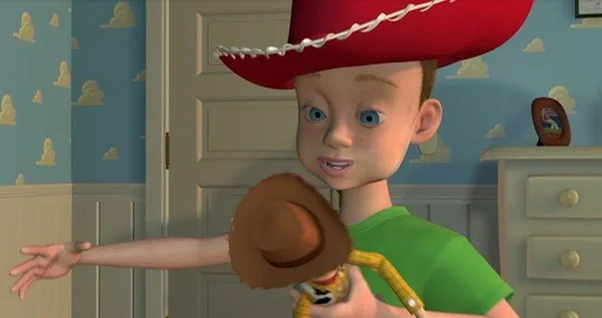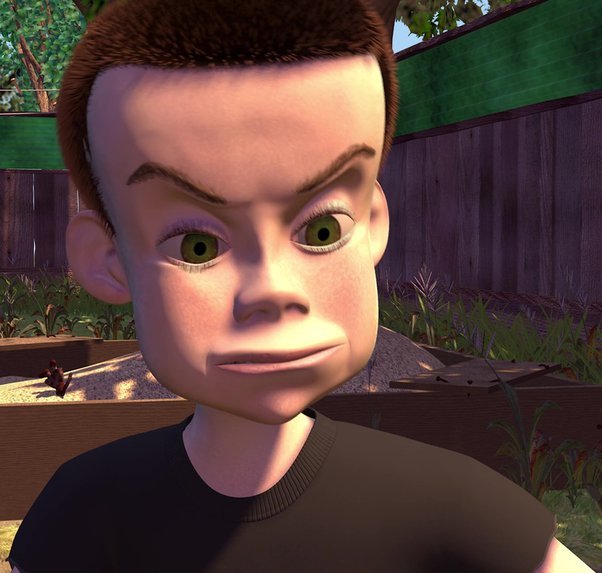Pixar, Toy Story and the Uncanny Valley
One of my great joys in life is experiencing pop culture through the eyes of my eight year old son Declan-Haven. I love going to see new movies with him like Barbie and Teenage Mutant Ninja Turtles: Mutant Mayhem for my Substack newsletter Nathan Rabin’s Bad Ideas.
But I also love watching older films with Declan because he is at an age now where his big, beautiful brain is a sponge that soaks up everything he sees and hears and experiences.
Declan is curious and endlessly enthusiastic. We’ve had a blast watching the newest Pixar movies and Tim Burton’s early work and Youtube videos related to his love of costumes and make-up and Disney and all things theatrical.
A week ago or so I re-watched Toy Story 3 with him for a piece I was writing for Fatherly about the enormous debt Barbie owes the Toy Story and Lego Movie franchises.
He loved it. I always know when Declan is digging something because he gets this ecstatic look on his face, starts stimming by flapping his arms and will sometimes grab me when he’s feeling particularly excited.
My son has ADHD and Anxiety so he does not process things the way a neurotypical child would do. He doesn't just watch movies or television shows with his eyes: he experiences them with his whole body. It’s very endearing.
To say that Toy Story 3 holds up would be a massive understatement. The last time I had seen it was in 2021, when I wrote about Ned Beatty’s wonderful, tricky and heartbreaking performance as Lotso, arguably the greatest villain in Pixar history. He’s certainly the most complex.
Thanks largely to Beatty’s performance as Lotso, a cuddly pink bear that smells like strawberries and cuts an unmistakably paternal figure despite nursing a fierce grudge against humanity, Toy Story 3 is incredibly dark.
I mean DARK. It’s even more death-fixated than the average animated film for children. But the darkness is intentional and powerful. Toy Story 3 takes us to the very brink of oblivion, when its lovable heroes are staring down death, so that its happy ending will mean something.
I love Toy Story 3. It might be my favorite entry in the series and I am a fan. If nothing else, it has Michael Keaton’s hilarious turn as adorably idiotic fashion plate Ken.
I loved the darkness of Toy Story 3. I loved the voice acting, particularly Tom Hanks as Woody. I loved the storytelling. I loved the script. I loved the characters. I loved the world-building.
In fact I loved just about everything about Toy Story 3 with one major exception.
Toy Story 3 came out during the heyday of the Uncanny Valley in animation. So while its animation of toys is wonderful and sleek and convincing its depiction of human beings is distractingly off.
Toy Story 3 at least marks a sizable improvement over its predecessors. When Toy Story came out in 1995 it was the first full length computer animated film. It was revolutionary. It marked the auspicious beginning of a new era in animation.
Toy Story was much better than anyone could have envisioned with one notable exception: Andy looked creepy as hell. That was probably to be expected, since the technology was new and better suited to animating animals and dolls rather than human beings.
Because the Toy Story series is the gold standard of computer animation I guess I assumed that it figured out how to animate humans before anyone else did but at its embryonic beginning as a feature film studio Pixar was seemingly as lost as everyone else was.
While researching this piece I read an article about how Pixar was so hard-up when Toy Story was made that they only had model for a boy and that was Andy. So in the birthday party scene, everyone apparently is just Andy with different clothes and hair colors.
Andy looked less creepy and more normal as the series went on and computer animation improved but in 2010 he was still unmistakably and distractingly off.
I mistakenly thought Pixar and Toy Story would be the exception, that they’d stampede out of the Uncanny Valley and into a world where human beings look like human beings, but not in a viscerally unnerving way.
There’s nevertheless something endearing about the clunkiness of early Pixar’s animation of humans. Pixar was the best right out of the gate. It continues to be the best twenty-eight long, eventful years later. Yet Pixar is not perfect and its imperfections can’t help but humanize it, as a studio and on a scene by scene basis.
Check out The Joy of Trash: Flaming Garbage Fire Extended Edition at https://www.nathanrabin.com/shop and get a free, signed "Weird Al” Yankovic-themed coloring book for free! Just 18.75, shipping and taxes included! Or, for just 25 dollars, you can get a hardcover “Joy of Positivity 2: The New Batch” edition signed (by Felipe and myself) and numbered (to 50) copy with a hand-written recommendation from me within its pages. It’s truly a one-of-a-kind collectible!
I’ve also written multiple versions of my many books about “Weird Al” Yankovic that you can buy here: https://www.nathanrabin.com/shop
Or you can buy The Joy of Trash from Amazon at https://www.amazon.com/Joy-Trash-Nathan-Definitive-Everything/dp/B09NR9NTB4/ref=tmm_pap_swatch_0?_encoding=UTF8&qid=&sr= but why would you want to do that?
Check out my new Substack at https://nathanrabin.substack.com/
And we would love it if you would pledge to the site’s Patreon as well. https://www.patreon.com/nathanrabinshappyplace







